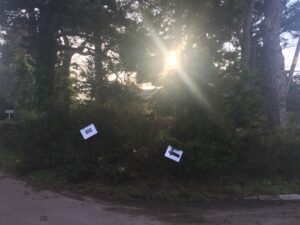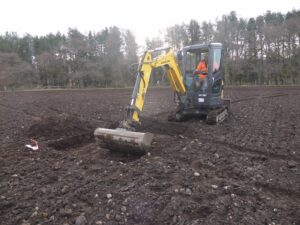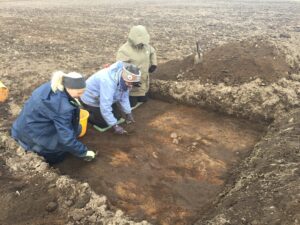
At the end of February I spent a long weekend in Aberdeenshire, investigating one of the largest, and most significant, hunter-gatherer sites in Scotland. Of course, I was not working alone, there was a big team of us including professional archaeologists, archaeology students, experienced volunteers from the local Mesolithic Deeside group, and related specialists to look at soils and sediments. The aim of our work was to assess the preservation of archaeological remains in the main field at Nethermills Farm, Crathes.
This site has been known since the 1970s when local collector Dr James Grieve amassed an assemblage of over 3000 flaked flints from the field, the majority of which were characteristic of Mesolithic activity. Excavation in the late 70s and early 80s by archaeologist Dr James Kenworthy uncovered a number of archaeological features, more flints, and organic materials indicative of a wide spread of activity dating from the Late Upper Palaeolithic (perhaps 12,000 years ago) to the Bronze Age (around 4000 years ago) but focussing on the Mesolithic (c. 7000 years ago). Kenworthy only excavated a tiny area of the field, but, of course, farming has continued in the area and the archaeological traces in the ploughsoil extend across a number of fields along the banks of the River Dee. It was therefore important to assess the state of the site today, with a view to informing general management and any further investigation of the site.


In order to achieve this, we dug a series of test pits across the field. The field is a big one, for Scotland, though luckily the ploughsoil is not deep and the soil generally silty and friable. We were able to open over 100 pits, with the help of a small digger to strip off the topsoil. It never ceases to amaze me just how accurate an experienced digger driver can be. Each pit was then dug by hand, cleaning off the remaining topsoil down on to the subsoil surface in order to see whether there were any surviving archaeological features cut into the subsoil below the disturbance of the plough. In many places the subsoil was a nice compacted sand and it was a rewarding job to clean down to it with your trowel and reveal the bright orange surface. Below the sand lay a deep layer of alluvial gravels, however, and some teams found that they were cleaning straight on to this – a much more difficult task. Given the number of pits and the size of the field, it was hard work and the enthusiasm and skills of everyone involved was humbling. We were blessed with wonderful weather, I even spotted a bottle of sun cream in use on one day – not a common sight in north-east Scotland in February.

What of the results?
Well, we certainly found plenty of flints, but we knew there would be plenty to find! Sadly, below the ploughsoil, only very truncated remains of anything archaeological had survived. There was also abundant evidence of the activity of burrowing animals, from otter-sized holes to something more like moles, and that never bodes well for archaeology. So, it seems that the archaeological potential of the fields in terms of surviving remains is negligible. That certainly makes management easier.


Nevertheless, the significance of the field, and neighbouring fields, in terms of our understanding of prehistoric activity along the River Dee remains high. The Dee is an exciting river because there are early sites along its length, from the source, up in the Cairngorms, to the sea, at the city of Aberdeen. It offers the opportunity to explore some of the first hunter-gatherer communities as they moved into Scotland at the end of the last Ice Age and to investigate how they related to the world around them.

For me it was a great weekend. I’ve not actually done any digging for twenty years. Truth be told, I did not really do any this weekend. I’m good at strutting around. But it was fabulous to have the opportunity to be there as the site was slowly uncovered and to discuss the finds. I’ve always enjoyed the social side of archaeology as well as the academic and this dig was no exception. The team encompassed such a variety of people, all united in their desire to push the project forward. It reminds you what archaeology is all about and it is an experience I can recommend if you have not tried it. There are all sorts of different tasks to be done – you don’t have to be super fit! There are local archaeology groups and courses all over the place, find one and join in.

Of course, something like this does not take place without funding and advice. Historic Environment Scotland, Aberdeen University, and Aberdeenshire Council Archaeology Service provided financial support and Bruce Mann, Heather and Dinkar Sabnis and many others provided advice and encouragement, not to mention all those who took part. Just occasionally I do feel a tad guilty that it is all so much fun – can this really be part of a serious career?
You must be logged in to post a comment.